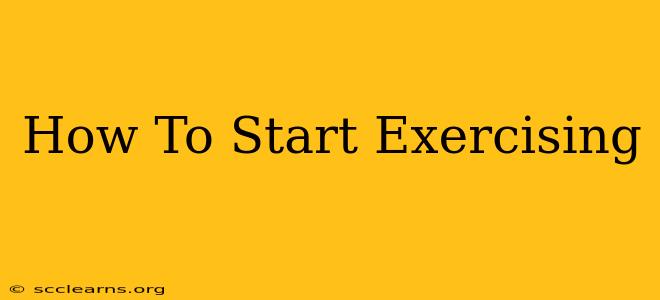Starting an exercise routine can feel daunting, but it doesn't have to be! This guide will walk you through the essential steps to begin your fitness journey safely and effectively, whether you're a complete beginner or just looking to reignite your passion for physical activity. We'll cover everything from setting realistic goals to choosing the right exercises and staying motivated.
1. Consult Your Doctor: The Crucial First Step
Before embarking on any new exercise program, it's vital to consult your doctor or physician. This is especially important if you have any underlying health conditions, haven't exercised in a while, or are over 40 years old. A checkup can help identify potential risks and ensure you're starting safely. This preventative measure is key to avoiding injuries and maximizing the benefits of your workout routine.
2. Setting Realistic and Achievable Goals
One of the biggest mistakes beginners make is setting unrealistic goals. Instead of aiming for drastic changes overnight, focus on small, achievable steps. Start with just 15-20 minutes of exercise, three times a week. Gradually increase the duration and intensity as your fitness level improves. Remember, consistency is key!
Examples of achievable goals:
- Goal 1: Walk for 20 minutes, three times a week for the first month.
- Goal 2: Increase walking time to 30 minutes, three times a week in the second month.
- Goal 3: Introduce strength training exercises twice a week in the third month.
Don't get discouraged if you miss a day or two. Just get back on track as soon as you can.
3. Choosing the Right Exercises for You
There's a vast array of exercises to choose from, catering to different preferences and fitness levels. Beginners should focus on activities that are:
- Low-impact: These exercises minimize stress on your joints, reducing the risk of injury. Examples include walking, swimming, cycling, and elliptical training.
- Enjoyable: If you don't enjoy your workouts, you're less likely to stick with them. Choose activities you find fun and engaging. This could be anything from dancing to hiking to playing a sport.
- Accessible: Choose exercises you can easily incorporate into your daily routine. This might mean walking during your lunch break or following a home workout video.
4. Creating a Workout Plan
Once you've chosen your exercises, create a simple workout plan. This will help you stay organized and motivated. A sample plan could look like this:
Week 1-4:
- Monday: 20-minute brisk walk
- Wednesday: 20-minute brisk walk
- Friday: 20-minute brisk walk
Week 5-8:
- Monday: 30-minute brisk walk
- Wednesday: 30-minute brisk walk
- Friday: 30-minute brisk walk + 10 minutes of bodyweight exercises (squats, push-ups, lunges)
Remember to adjust this plan based on your progress and preferences. Listen to your body and take rest days when needed.
5. Staying Motivated: Tips and Tricks
Staying motivated is crucial for long-term success. Here are some tips:
- Find a workout buddy: Exercising with a friend can provide support and accountability.
- Track your progress: Keep a journal or use a fitness tracker to monitor your achievements. Seeing your progress can be incredibly motivating.
- Reward yourself: Celebrate your milestones with non-food rewards, like a new workout outfit or a massage.
- Make it a habit: Schedule your workouts like any other important appointment. Consistency is key.
- Listen to your body: Rest is important. Don't push yourself too hard, especially when starting.
6. Incorporating Nutrition and Rest
Exercise is only one piece of the puzzle. Proper nutrition and adequate rest are also essential for optimal health and fitness. Focus on a balanced diet rich in fruits, vegetables, whole grains, and lean protein. Aim for 7-9 hours of sleep per night to allow your body to recover and repair.
Starting an exercise routine is a journey, not a race. Be patient with yourself, celebrate your successes, and enjoy the process of becoming a healthier, fitter you. Remember to prioritize consistency and listen to your body!

